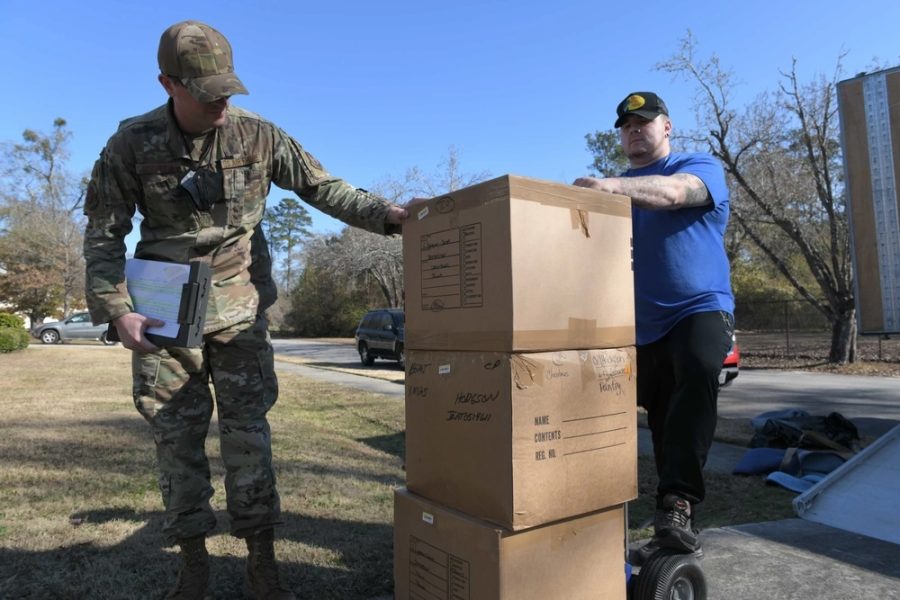It was the summer Permanent Change of Station (PCS) season, and the Air Force had run out of personnel funding, leaving about 27,000 people temporarily stranded overseas. Some Airmen and their families could not move back stateside until well after the start of the new school year.
“It will have an effect on recruiting patterns and retention,” an Air Force general said at the time. “It has implications for the morale of our force. And it constitutes one of the most significant challenges to face Air Force leaders[.]”
Though this story may sound like the personnel funding shortfall in July 2023, it actually took place in 1986 amid similar circumstances. Congress at the time wanted to reduce the federal deficit through budget cuts. Those cuts, combined with increased travel costs, per diem benefits, and higher-than-expected retention levels, left the Air Force short of cash for PCS moves. The funding issues continued in 1987, where the Air Force was short $478 million in military personnel appropriation (MPA).
“Reprogramming of other Air Force dollars into the MPA will be required to avoid actions with drastic mission and personnel implications,” Lt. Gen. Thomas Hickey, then-deputy chief of staff for personnel at Headquarters Air Force, wrote in a 1987 op-ed. “We have a significant funding problem that poses a challenge to Air Force leadership at every level.”
Fast-forward to July 2023, a time when inflation, higher-than-expected PCS costs and retention again left the Air Force short of personnel funding. The branch delayed some PCS moves and stopped awarding new bonuses, leaving many Airmen and their families in limbo. After a few weeks, The Air Force reinstated bonus programs and processed PCS orders when Congress finally approved the Pentagon’s request to reprogram personnel funds, but the experience anguished many families.
“Plans to sell or buy a house or car, enroll children in schools and daycares, transition jobs for spouses and partners, or deliver babies in known or planned locations evaporated under the PCS pause,” wrote RAND political scientist Kelly Atkinson in a July 31 commentary.
The pause was particularly disruptive for dual-military couples where one member was approved to move while their spouse was delayed, wrote Atkinson, an Air Force reservist. Dual-military couples or members facing increased financial hardship often had to seek exceptions to policy to resolve their situation.
“When policy creates situations where people are exceptions, and not included in policy, then that can have impacts on sense of belonging and sense of motivation for recruitment and retention,” Atkinson told Air & Space Forces Magazine, noting that her views do not necessarily represent those of the Air Force or the Department of Defense.
Personnel funding is a recurring issue in the Air Force, and the unpredictable nature of Congressional funding means that the Air Force cannot eliminate the possibility of a shortfall.
However, according to one group of experts, the Air Force can reduce the likelihood of a shortfall by more closely integrating policy owners, forecasting outcomes through the use of policy games, and measuring the effects of policy changes with better data.
When a shortfall does occur, the service must also improve its guidance to families to mitigate its impact, Atkinson said, “rather than leaving them with the burden of adjustment in complex circumstances.”
What Is MILPERS?
The Air Force military personnel (MILPERS) budget includes pay and allowances, health care and retirement pay accruals, PCS travel, and other funding that goes towards running people programs, RAND researchers explained in a 2023 report.
In fiscal 2021, the MILPERS budget was about $36 billion, more than 20 percent of the Air Force’s total $168 billion budget. Between 2000 and 2021, spending on active-duty personnel grew at an average rate of 3.3 percent a year, RAND found, faster than the overall economy’s price growth of 1.9 percent a year.
Pay raises mandated by Congress drive a large portion of MILPERS, RAND senior operations researcher and retired Air Force veteran Lisa Harrington told Air & Space Forces Magazine. Having a large MILPERS budget helps retain talent, but the tradeoff is that the Air Force does not have as much flexibility for modernizing and responding to operational demands.
Reducing MILPERS is a painful calculation where planners must either shrink the size of the force or cut the cost per Airman. Some levers include reducing or delaying accessions, accelerating people out of the service, slowing promotion rates, and shifting responsibilities from officers to enlisted Airmen. There is no “correct” solution, wrote RAND researchers, only tradeoffs between priorities.
“This is a crippling problem,” they wrote. “The workforce is the foundation for readiness, yet the [Department of the Air Force] … must maintain fiscal flexibility to meet other immediate and future needs.”

Better Data, Better Integration
Part of the problem is a lack of data. For example, the Air Force often lacks accessible information on the impact of past bonuses or incentive pays on accessions and retention.
“I can’t tell if a really big bonus offered 10 years ago to people working with computers was effective, because I can’t go back and see if the person who was offered the bonus got out or stayed,” Harrington said. “We really do need to be capturing the decision space of the individual Airman in the work we do.”
Even with better data, service officials are not as closely integrated as they could be when it comes to forming personnel policies. For example, Harrington explained that there is an Air Force policy area which calculates special pays and bonuses in order to retain a certain number of Airmen with important skill sets. There is another policy area planning out how many new recruits the Air Force should bring in every year.
But those two programs are not always on the same page.
“Generally speaking, those policy areas are relatively disconnected,” Harrington said. “In our reports, we call for bringing those people responsible for human capital policies together to talk about this in one big group, because there are second order effects across all of these policy changes.”
Force protection is one example of an operational decision with secondary effects on MILPERS. Security Forces is the largest career field in the Air Force, so a decision to expand or reduce base protection could have a large ripple effect on the overall MILPERS budget.
“If you change the way you operate, you may have to change the personnel that you need,” Harrington said. “Are our ops, planning, and logistics thinking about the manpower implications and the MILPERS implications of the decisions they make?”

Money Games
In a “whole of Air Force” experiment, RAND invited Air Force officers, enlisted Airmen, and civilians from across the service to take part in a workforce futures policy game. Games are well suited to tackle complex problems where no single planner has complete knowledge of a system, researchers wrote.
“Even prior to conducting the game, the exercise of defining inputs, outcomes, and metrics with senior leaders and stakeholders from the Air Staff was tremendously informative,” they said. “As explained by one stakeholder, although the USAF does not control annual changes in basic pay, results from the game could be used to make a more informed argument to Congress for reforming how annual adjustments are calculated.”
When stakeholders work together, it should improve the efficiency of MILPERS policies and reduce the risk of a shortfall, Harrington said. Better integration might also help the department prepare for what to do in the case of a shortfall, which could better inform guidance for service members.
Better Guidance
Even the best-laid plans can be upended by politics. This past summer, the personnel funding shortfall was exacerbated by a dispute between lawmakers about whether to locate U.S. Space Command headquarters in Alabama or Colorado. When contingencies arise, the Air Force needs to be better prepared to communicate next steps for Airmen and their families, said Atkinson.
“Leadership is key, and the Air Force could leverage this challenge as an opportunity to demonstrate its dedication to caring for Airmen and their families despite structural limitations like budget shortfalls,” she wrote.
The 2023 shortfall had a disproportionate effect on female service members, who make up a higher percentage of dual-military marriages compared to active-duty male service members, Atkinson wrote. The political scientist witnessed the confusion and frustration her fellow service members faced in online forums where they tried to help each other navigate the PCS delay. For Atkinson, the experience reinforced the importance of diversity, equity, and inclusion efforts in the service.
“If you have those members in the room who say, ‘I’ve experienced this, I have a joint spouse career,’ or ‘I’ve utilized childcare, and I know about the gaps,’ then they can incorporate that perspective into policy, which will then better reach diverse elements of the population,” she said.
Atkinson pointed out then-Air Force Chief of Staff Gen. Charles Brown’s comment before the Senate Armed Services Committee that “the spouse network is alive and well, and the spouses will compare notes” about the shortfall. If senior leaders have a better sense for the hoops that Airmen have to jump through when a shortfall occurs, perhaps they can craft better guidance that won’t leave Airmen feeling adrift the way many did last summer, she said.
“We need to continue paying attention to those human experiences within this institution, whether that’s through holding town hall sessions, coffee talks,” or other forums, Atkinson said. “More of that is good, because it connects policy makers with the individuals who are then living the outcome of the policies that they set.”
